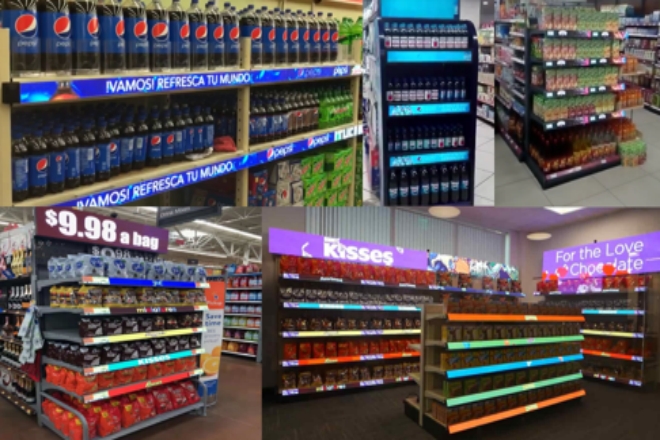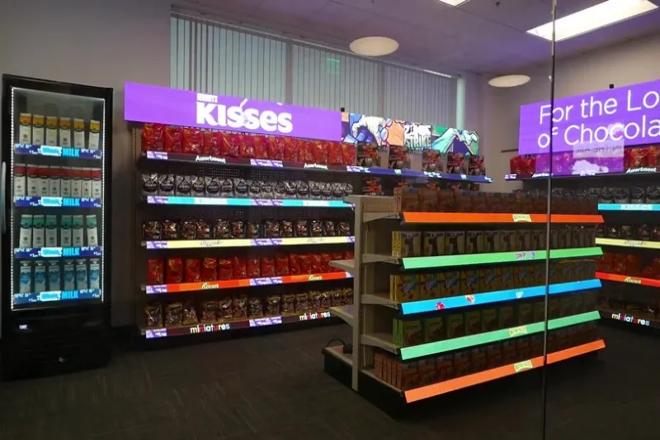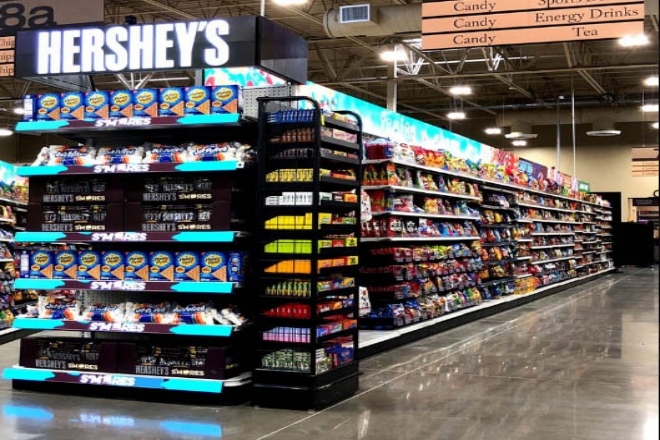介绍

The retail battlefield is full of smoke, and every detail is related to victory or defeat. Imagine using shelf LED display to instantly attract customers and make your store stand out. But how to judge whether it is suitable to introduce?
Don’t worry, this article hits the point directly, through the four-step analysis method, to help you quickly judge and plan, making the decision simple and clear. Follow us to unlock a new chapter in retail!
Step 1: Analyze the target customer group
Before introducing a shelf LED display, the first task is to deeply analyze our target customer group. This step is crucial because it is directly related to whether you can accurately meet customer needs and maximize marketing effects.
1). Target customer characteristics:
You need to clarify who the main customers of the store are, their age level, gender ratio, professional background, and consumption habits.
For example, a clothing store for young and fashionable people may have a customer base of 20-35 years old urban white-collar workers who pursue trends, pay attention to quality, and are accustomed to obtaining information through social media and digital channels.
2). Demand matching:
Next, you evaluate whether the shelf LED display can effectively meet the needs of these target customers. This includes the convenience of information acquisition, the fun of entertainment interaction, and the accuracy of personalized services.
For the above-mentioned young and fashionable customer groups, a shelf LED display screen with rich content, fast updates, and the ability to interact with customers can undoubtedly greatly enhance their shopping experience.
It can not only display new product recommendations and promotional information in real-time but also increase shopping fun through interactive games, lucky draws, etc., thereby enhancing customer stickiness and improving satisfaction.
3). Conclusion Summary:
Based on the above analysis, you can preliminarily judge that the introduction of shelf LED displays has a positive effect on improving the shopping experience and satisfaction of the target customer groups.
Of course, this also needs to be considered in combination with subsequent store layout, cost-benefit analysis, market trends, and other factors.
However, in any case, an in-depth understanding of and meeting the needs of target customers is always the starting point and foothold for our marketing strategy.
Step 2: Evaluate store layout and space

Before deciding to introduce shelf LED displays, a detailed evaluation of the existing layout and space of the store is an indispensable part. This step will directly affect the installation effect of the display and the overall operation of the store.
1). Space adaptability:
First, you need to accurately measure the size of the space in the store that can be used to install the shelf LED display.
In this process, not only should the size of the display screen itself be considered, but enough space should also be reserved to ensure that it is installed firmly and does not affect the normal flow of customers.
At the same time, the shape and installation location of the display screen are also key factors. It is necessary to fully consider its potential impact on the customer flow line and product display to ensure that it does not affect the customer’s shopping experience and can effectively attract their attention.
2). Visual effect evaluation:
Next, use professional design software or hand-drawn sketches to simulate the store layout after the display screen is installed. This process is designed to intuitively show how the display screen integrates into the store environment and its role in improving the overall visual effect.
You need to evaluate whether the color, 亮度, 解决 and other parameters of the display screen are coordinated with the store style to ensure that it will not cause visual congestion or interference while conveying information but will add a touch of color to the store.
3). Safety compliance:
Safety is always the primary consideration. During the evaluation process, you must carefully check whether the store structure, power supply, etc., meet the safety standards and specifications for installing shelf LED displays.
This includes but is not limited to inspections of store load-bearing capacity, wire layout, fire protection facilities, etc., to ensure that the installation of the display screen does not pose a threat to store safety.
4). Conclusion summary:
Combining the evaluation results of the above three aspects, you can draw a conclusion on whether the store has the hardware conditions to install a shelf LED display.
If the store space is sufficient, the visual effect is ideal, and the safety compliance is guaranteed, then the introduction of a shelf LED display will be an option worth considering.
On the contrary, if there are obvious space limitations, poor visual effects, or safety hazards, we need to reconsider other marketing strategies or optimize the store layout to meet the conditions.
Step 3: Consider costs and benefits

When deciding whether to introduce shelf LED display, cost and benefit considerations are an indispensable part. This step is to help us comprehensively evaluate the economic feasibility of the project and ensure the rationality of the investment decision.
1). Investment cost:
First, you need to list in detail the various costs of the shelf LED display, including but not limited to procurement, installation, and post-maintenance costs.
The procurement cost involves the price of the display itself and the cost of supporting equipment (such as controllers, power cords, etc.).
The installation cost covers the wages of the installers, transportation costs, and possible store renovation costs; and the maintenance cost includes long-term operating costs such as regular maintenance, software upgrades, and fault repairs.
In addition, the allocation of one-time investment and long-term operating costs must be considered in order to assess the overall investment scale of the project more accurately.
2). Expected benefits:
Next, you need to analyze the expected benefits that the display screen may bring. These benefits can be direct, such as increasing product sales and increasing customer purchase frequency, etc.; they can also be indirect, such as improving brand image and enhancing customer interaction experience.
Specifically, shelf LED display screens can attract customers’ attention and increase their desire to buy by dynamically displaying product information and promotional activities; at the same time, its high-tech sense and interactivity can also help improve the overall image of the store and enhance customers’ recognition of the brand.
In addition, by collecting customer interaction data, we can further optimize marketing strategies and improve marketing efficiency.
3). ROI analysis:
After clarifying the investment cost and expected benefits, you need to calculate the return on investment (ROI). ROI is an important indicator for measuring the economic benefits of a project.
It represents the ratio of the project’s net income to the investment cost. By comparing the present value or future value of the investment cost and the expected benefit, you can calculate the ROI of the project and evaluate its economic feasibility accordingly.
If the ROI is high, it means that the project has high profitability and is worth investing in; otherwise, it needs to be considered carefully.
4). Conclusion:
Based on the above cost-benefit analysis, you make a final judgment on whether the introduction of shelf LED displays is a cost-effective investment decision. If the project is expected to bring significant benefits and the ROI is high, then it would be a wise move to introduce the display.
If the cost is high and the expected benefits are limited, it is necessary to re-evaluate the project plan or consider other alternatives. In this process, we need to maintain rational thinking and comprehensively consider various factors to ensure the scientificity and rationality of the investment decision.
结论
In summary, as one of the important elements of the modernization of retail stores, the introduction of shelf LED displays needs to be carefully considered and comprehensively evaluated.
Through the precise positioning of the target customer group, the reasonable planning of store layout and space, the detailed analysis of costs and benefits, and the keen insight into market trends and competitive situations, retail store owners can more clearly judge whether their stores are suitable for upgrading with shelf LED display as the theme.
最后,如果您想了解更多关于LED显示屏的知识, 请与我们联系。
